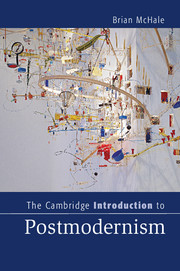Book contents
1 - Before Postmodernism
Published online by Cambridge University Press: 05 July 2015
Summary
Postmodernism and Its Precursors
What was new about postmodernism? How new was it? In the days when postmodernism was still controversial, one frequently heard objections along the lines of, “Postmodernism – it's all been done before” or “It all derives from [fill in the blank].” A favorite candidate for filling in that blank was Friedrich Nietzsche, the late-nineteenth-century German philosopher whose radical skepticism certainly informed the poststructuralist theories of Michel Foucault, Gilles Deleuze, and many others from the sixties on (McGowan, 1987, 70–88). But the hypothesis of a Nietzschean origin, or any other philosophical origin for that matter, rests on the assumption that postmodernism is essentially a philosophical tendency, identifiable with what would come to be called “Theory.” This assumption is at odds with my own sense of postmodernism as essentially an aesthetic and cultural tendency, of which the emergence of Theory is just one indicator among others (see Chapter 3).
As for the objection that “it's all been done before,” here the objectors were abetted by the retro orientation of some varieties of postmodernism, manifested in the recycling, rewriting, pastiching, or parodying of historical styles, genres, or even specific texts (see “Alice” and “Prospero's Books”). Further corroboration could be found in postmodern architecture's revival of certain features of classical style, typically with an ironic twist. Classical architecture's “universal grammar and syntax” of columns, arches, domes, and decoration (Jencks, 1984, 147) was a conspicuous feature of such characteristic postmodern buildings as Michael Graves's Portland Public Services Building (1980–82), James Stirling's Neue Staatsgalerie in Stuttgart (1977–84) and Charles Moore's Piazza d'Italia in New Orleans (1976–79) (see “Ruins”). But ironic neoclassicism was only one strain of postmodern architecture, “one style among several: not the sole approach but the most public one” (Jencks, 1984, 164), and it played little role outside architecture.
- Type
- Chapter
- Information
- The Cambridge Introduction to Postmodernism , pp. 8 - 21Publisher: Cambridge University PressPrint publication year: 2015
- 1
- Cited by



